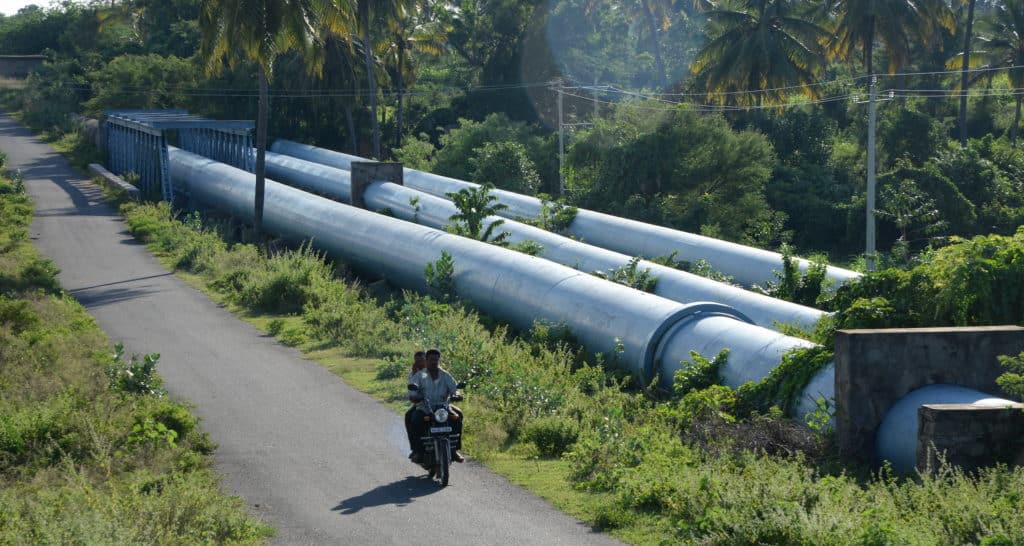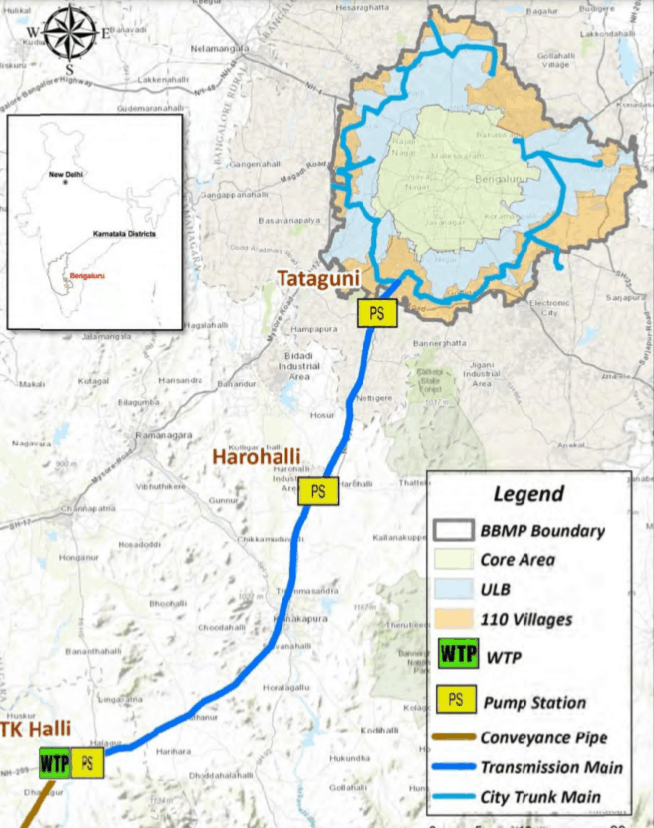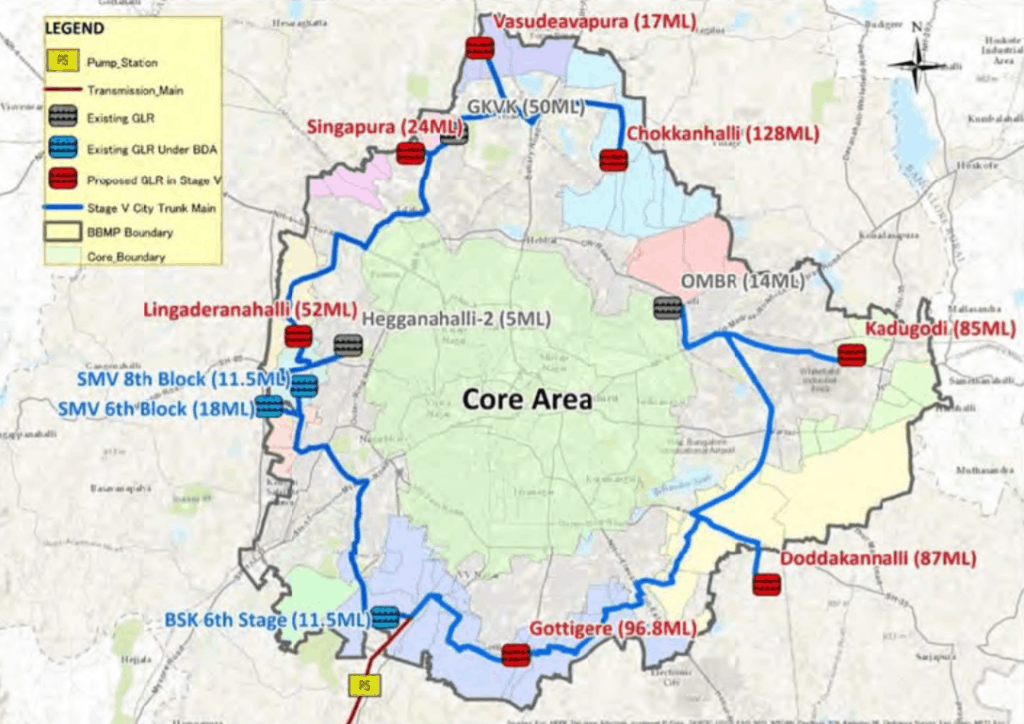Bengaluru’s peripheries – the 110 villages that were added to the city in 2008 – have long depended on private tankers for water supply. The Bangalore Water Supply and Sewerage Board (BWSSB) had promised them water supply by 2023 through its Cauvery Stage V project.
Cauvery Stage V project aims to bring in an additional 775 MLD (Million Litres per Day) water from river Cauvery into Bengaluru city. As per the final project report in 2017, the total demand for the 110 villages was calculated to be 350 MLD as of 2024. The report says demand is expected to go up to 800 MLD in 2049, and additional requirements at the time can be met through borewell water supply.
With only two years left to the 2023 deadline, what’s the status of the project?

Many works are at very early stages
B M Somashekar, Engineer-in-Chief (Addl) says work on the distribution lines within the 110 villages have been nearly complete. In early June, Chief Minister B S Yediyurappa also announced that the pipeline-laying work in the villages had been completed.
However, work on the main transmission and trunk lines are in the very early stages. S V Ramesh, Chief Engineer (Kaveri)(Addl), who is in charge of these works, says tenders have been awarded for all the components of the water supply project, and they are in different stages of progress. He added that work had lagged due to COVID lockdowns over the past year. “Work didn’t happen for three months last year, and three months this year. But we are getting additional labour to complete the work on time.”
Read more: 12 years after Bengaluru’s water board made RWH a rule, how are we doing in harvesting rainwater?
As shown in the image below, Cauvery water is first treated at the 775-MLD water treatment plant (WTP) at TK Halli outside Bengaluru. From TK Halli, the water is pumped to Harohalli and then Tataguni pumping stations, before it reaches the city at a point named Vajarahalli, near Banashankari 6th stage.

Ramesh says the conveyance line that brings water up till TK Halli already exists. But construction of the water treatment plant at TK Halli has just started; as of early May, only 4% of the work had been completed, according to him.
The transmission line that carries water from TK Halli to Harohalli pumping station is 43 km long. As of early May, 14.7 km (34%) of this work had been completed. Further, the transmission line from Harohalli to Vajarahalli (the entry point to the city) is around 28 km long. Of this, only 5 km (18%) had been completed in early May.
BWSSB is also supposed to build Ground Level Reservoirs (GLRs) at the three pumping stations – TK Halli, Harohalli and Tataguni. Only 4-5% of works on these GLRs were complete as of early May.
BWSSB’s trunk lines supply Cauvery water east and west
Once the water enters the city at Vajarahalli, two trunk lines carry the water into the peripheral areas – one towards the east and the other towards the west. The trunk main along the eastern direction takes the water to the Ground Level Reservoirs (GLRs) in Gottigere (off Bannerghatta road), Doddakannalli (off Sarjapura road), and Kadugodi (near Whitefield). This trunk line spans a total of 54 km, of which only 7 km (13%) had been done as of early May. The diameter of this trunk line ranges between 800 mm and 2300 mm, says Ramesh.

In the western route, the trunk line starts from Vajarahalli and goes towards the GLRs in Lingaderanahalli (near Sunkadakatte and Nagarbhavi), Singapura (near Jalahalli), Vasudevapura (near Yelahanka) and Chokkanahalli (near Jakkur). Ramesh says the GLR planned at Vasudevapura has been shifted to Sir MV Layout because of a property dispute. The line spans a total of 56 km, of which 15 km (27%) had been completed as of early May. The diameter of this pipe ranges between 1500 mm and 2600 mm.
Other than Vasudevapura, the land for some other proposed GLRs were also under dispute, and their works have just started after resolving those. Progress of works vary – for example, work on Gottigere GLR has just started, while that on Singapura GLR has progressed to 20%. In the case of Kadugodi GLR, the land is still under the Forest Department; talks are going on, and the land would be transferred to BWSSB in 2-3 weeks, says Ramesh.
Read more: How is Cauvery water supply treated for contamination?
With works progressing slowly, it’s unclear if residents in outer areas will indeed get Cauvery water in 2023 itself. Many residents in these areas have been skeptical of taking Cauvery connections even otherwise. In Part 2 of this series, we explore why.
Bangalore law makers are more interested in bring water from 200 kms away without exploring fully the locally available solutions on water conservation like rain water harvesting , water aerators , STP , water meters etc. Law makers hv become bankrupt of ideas as project delays resulting in cost overruns and contractors known to the decision makers looting the public exchequer has become a common experience across the country . There is hardly any party of late works for welfare if common citizens . It is only ‘ Swaha’ everywhere !
I want to bring into notice of District Admin that water coming from 200 km cavery canal is surface water which is light weight in nature and easily pores into soil and then evaporates with sunny day and damage the talukas of the underground water so please stop surface water and use only Groundwater otherwise one day will come we need to evacuate all the Citizens from bangluru city
Will it take 3+ years to make 70 KMs of main lines with precast pipes ? Which era are we living in ..Shame on BWSSB ..
They went ahead and took big money for connections and took a book a compulsary bond from residents that we will not ask for connection till it comes ..
BWSSB leadership has nothing to feel proud of..
Time to wake up. Government must speed up MEKEDAATU project and bring the drinking water to Bangalore, otherwise city will starve from SD shortage of water
What about Electronic City sourended villages supply with cauvery water. We espect BWSSB water? in the area
In Ullala area water supplying is Cauvery ?
Water is salty. Can you give the confirmation it’s Cauvery or not .
All lakes which are enchroached need to be restored and desilted for rain water storage and ground water recharge
such a basic thing like water should never be hard to get. It’s just bureaucracy that is delaying this.
It is a boon for the residents of those area who are facing lot of water problems during summer because drying of borewells and get rid of hard water usage causes degeneration of bones.